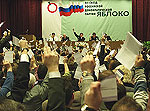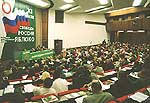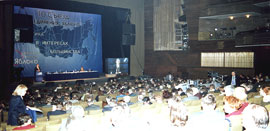Alexei Arbatov on the US deployment of previously banned complexes in Asia: “This situation is fraught with a new missile arms race”
Kommersant, 22.04.2024
Photo: Alexei Arbatov / Photo from the personal archive
Past week, the United States deployed medium-range ground-based missile systems in the Asia-Pacific region for the first time (see Kommersant on 16 April): army Typhon systems were deployed to the Philippines as part of the exercise. Previously, such weapons were prohibited under the Russian-American Treaty on Elimination of Intermediate-Range and Shorter-Range Missiles. The Russian Foreign Ministry warned that the emergence of American ground-based medium- and shorter-range missile systems in any region could lead to Russia abandoning its voluntary moratorium on the deployment of such systems on its territory. Kommersant correspondent Yelena Chernenko spoke with Academician Alexei Arbatov, head of the Centre for International Security at the Institute of the World Economy and International Relations of the Russian Academy of Sciences, , about the background and possible consequences of this situation.
Question: What are the consequences of this situation?
Alexei Arbatov: In general, this situation is fraught with a new missile arms race in the Asia-Pacific region. The United States’ motivations for the possible deployment of these systems are understandable. And here it is worth to recollect history. When the Soviet Union achieved parity in the late 1970s and deprived the United States of the advantage in strategic multiple warhead missiles, the United States resorted to an asymmetrical next move.
Referring to the Soviet medium-range Pioneer (SS-20) missiles, they began deploying Pershing II nuclear missiles and Gryphon cruise missiles in Europe in 1983 to gain asymmetric advantage. The medium-range missiles of the Soviet Union did not reach the United States, and the planned 600 American nuclear missiles (it should be noted that now, according to the Strategic Offensive Arms Treaty, START-3, the parties are allowed to have 700 strategic carriers each) from Europe could reach the most sensitive targets with the shortest warning time, including centres for the placement of state leadership and management of strategic forces.
This caused great concern in the Soviet Union, but the political situation soon changed, and in 1987 the the Treaty on Elimination of Intermediate-Range and Shorter Range Missiles was concluded. This was a great historical breakthrough, although later in Russia they criticised that agreement at all levels, since twice as many of our missiles [than American] were eliminated. However, it was not a matter of arithmetic, but of strategic higher mathematics. The Soviet Union essentially got rid of the strategic nuclear threat, and the United States eliminated the threat not to itself, but only to its European allies. That treaty had no impact on the potential for a strategic strike against the United States, since our medium-range missiles did not reach them.
Question: Are you implying that history repeats itself?
Alexei Arbatov: That’s it. They (the US – Kommersant), apparently, are working according to the same pattern and now, it seems to me, they have decided to reproduce this game with China. The Celestial Empire is developing its strategic forces, apparently hoping to reach parity with the United States in order to become equal to them in this area. The United States is very worried about this, since for the first time in history it will have to confront two nuclear superpowers on parity terms. Apparently, they decided to play the same card a second time and deploy medium-range missiles near China, to which China cannot respond symmetrically for geostrategic reasons.
Question: Will this create a risk for China In a military sense?
Alexei Arbatov: Certainly. Typhon launchers can launch both shorter-range missiles based on the SM-6 system (up to 500 km) and medium-range Tomahawk-type cruise missiles (up to 1,800 km). If in the future they are replaced by hypersonic systems of sufficient range (for example, up to 2,800 km, like the Dark Eagle system), then the flight time will be minimal. Although they are now being created for high-precision conventional warheads, these systems will jeopardise the most sensitive centres of the military-political leadership, and even China’s strategic forces, if deployed in sufficient numbers.
The main motive of the Americans is to kill two birds with one stone and create a military counterbalance to both medium-range systems and strategic weapons of China, which are not limited by any treaties. Here lies another reason: to force China to sit down at the negotiating table on limiting both strategic weapons and medium-range systems. However, the United States has not yet formulated for itself what principles could form the basis of these negotiations, but in any case they want to create a lever of political and psychological pressure on Beijing.
Question: So China is the primary factor for the United States when deploying new types of weapons?
Alexei Arbatov: Certainly. Now we are talking about the Philippines, and this supposed training deployment is aimed solely at China. If they had Russia in mind, they would have deployed them in Europe, taking advantage of the current tense situation. Some European countries, I think, would happily agree to such a step.
Question: A similar installation was brought to Europe for the first time several months ago; it was used as part of an exercise on the Danish island of Bornholm.
Alexei Arbatov: Yes, and then a certain signal was sent to Moscow. But the current system with the SM-6 missile is most likely an intermediate, experimental option. If something is deployed on an ongoing basis, it will probably be more advanced systems – Tomahawk cruise missiles or the medium-range hypersonic missiles being developed. They will be directed primarily against China.
But there is no inscription on a missile “for China” or “for Russia”. Let’s say, in the case of a deployment in Guam, we have nothing to fear, it is too far away. But placement in Japan and South Korea is a different story. Our entire Far East is under attack. Therefore, Russia has already warned that it will respond to this symmetrically, refusing a voluntary moratorium on the deployment of ground-based medium-range missile systems on its territory. By the way, at one time we had a large group of medium-range missiles in Siberia, but it did not affect the territory of the United States, but was intended mainly against China.
Question: And the United States will again receive an asymmetric advantage, as in the early 1980s?
Alexei Arbatov: Not really, it could be worse for the United States now than when deploying medium-range systems in Europe. After all, we are neighbours with the Americans in the Far East – this is often forgotten. The deployment of Russian medium-range missiles in some areas of the Far East could directly put American territory at risk. For example, from Chukotka and Kamchatka it is just a stone’s throw to Alaska.
Alaska is literally stuffed with American strategic and other important military installations. Their main missile defence system, missile attack warning system, and aviation are deployed there. This also applies to other states on the west coast: there is a main base for strategic submarines, a missile defence position area, a missile test site, and large administrative and industrial centres.
Americans often do not think through such multi-move games. They believe that some move will change the situation in their favour, but in fact counter moves by the other side will leave them losing, as happened many times during the Cold War. However, they are not the only ones who make such miscalculations. One way or another, the launch of a new round of arms race in the Asia-Pacific region will harm the security of the United States, and not just China and Russia.
Question: The latest report from the Congressional Research Service explains the need to deploy new systems as follows: “Improvements to Russian and Chinese artillery systems present a challenge to the U.S. military, the Army in particular. In addition to the challenge of improved artillery system capabilities and new employment techniques, the proliferation of special munitions—such as precision, thermobaric, and top-attack munitions—has renewed concerns about the potential impact of Russia’s and China’s cannon and rocket artillery on U.S. combat operations and ground combat systems. In response to this challenge, the U.S. Army is seeking to improve its ability to deliver what it refers to as long-range precision fires by upgrading current artillery and missile systems, developing new longer-range cannons and hypersonic weapons, and modifying existing air- and sea-launched missiles and cruise missiles for ground launch by Army units.” How do you assess this line of argument?
Alexei Arbatov: The Typhon system is multi-purpose and can be loaded with missiles of different types and different ranges, including for use for operational-tactical purposes. Russia and China have a lot of such means, there is always competition here, and now it is being demonstrated by Russia and NATO countries in military operations in Ukraine. It is the medium-range missiles deployed near the territory of the other side that are of military and political importance. They are acquiring strategic importance as a means of attacking its centres of military-political control and strategic deterrence forces. Therefore, the conclusion of the INF Treaty in 1987 was a major turning point in the history of nuclear disarmament and paved the way for the reduction of strategic arms starting with the Strategic Arms Treaty (START I) of 1991.
Question: Russian President Vladimir Putin twice proposed that the United States and its allies agree on a regime that could replace the collapsed INF Treaty. In September 2019, and then in September 2020, Russia proposed to formalise a moratorium on the deployment of systems previously prohibited under this treaty anywhere, expressing readiness to discuss, among other things, measures to verify such agreements. But then neither the United States nor NATO countries as a whole were interested in this initiative. They expressed a desire to discuss it only in January – February 2022, when this topic was no longer a priority for Russia. Why do you think Western countries did not take Moscow’s proposal seriously and returned to it when it was too late?
Alexei Arbatov: Let us recollect how all the fuss started? Since President (US Donald – Kommersant) Trump announced that he was going to withdraw from the Intermediate-Range Nuclear Forces Treaty not only because Russia was accused of violations, but most of all because China was allegedly deploying thousands of medium-range missiles that hold the entire Western Pacific Ocean and all American allies under attack. Presumably, the American air and naval forces in the Pacific were not enough, because all of their airfields and naval bases on the islands along the Chinese coast could come under attack from Chinese missiles. Ground mobile missiles were considered a more survivable and effective deterrent. If we are talking about deployment on Guam (which is easier politically, as on the US-controlled territory), then this will most likely be a rear deployment. If the situation escalates, American missiles can be transferred to bases closer to mainland China.
Question: Well, yes, the then US Presidential National Security Adviser John Bolton, when he came to Moscow to announce withdrawal from the INF Treaty, in an interview with Kommersant did not even hide that it was China, and not the alleged Russian violations, that was the main factor for the United States.
Alexei Arbatov: Russia, in order to resolve contradictions regarding compliance with the INF Treaty, went far, agreeing, among other things, to verify the absence of 9M729 cruise missiles on its European part, even despite the fact that the Russian authorities rejected US accusations against them and emphasised that these missiles were not subject to Articles of the INF Treaty. But for the United States the main problem was already China at that time. It is interesting that the (US President Joe – Kommersant) Biden Administration, having canceled a number of nuclear programmes during the Trump era, did not cancel new ground-based medium-range missile systems – on the contrary, it continued to develop them.
Question: Is it still possible to prevent an arms race in the segment of ground-based medium- and shorter-range missile systems? After all, the Pentagon has already announced that they will deploy new complexes in the Asia-Pacific region on a permanent basis by the end of the year.
Alexei Arbatov: After the denunciation of the INF Treaty, Moscow proposed agreeing on a moratorium on the deployment of such systems, and, among other things, this initiative was included in the package of agreements that was transferred to the United States and NATO in December 2021. The United States and alliance member countries rejected most of the demands contained in these documents, but agreed to discuss a moratorium on the deployment of medium- and shorter-range ground-based systems. However, at that time it was already a peripheral issue; the whole pattern of relations between Russia and the West had radically changed.
And now the general situation is also unfavourable for this. Russia has several times rejected the US proposal to begin negotiations on a treaty to replace the New START Treaty, which expires in 2026. According to the Russian side, there are no conditions for this now, since the United States has set itself the goal of “strategic defeat” of Russia in Ukraine and is putting unprecedented sanctions pressure on it. Against this background, it would be very artificial to take and selectively raise the issue of non-deployment of medium-range missiles in Asia, especially since there is a third party that plays a decisive role in this issue.
Question: Do I understand you correctly that this issue can no longer be resolved diplomatically?
Alexei Arbatov: A diplomatic settlement of the problem would be better than being drawn into a new channel of the arms race in the Asia-Pacific region. In addition to the general unfavourable situation for arms control, there are now not two players, but at least three, which, certainly, greatly complicates diplomatic work. However, when the political situation changes for the better and in the context of the resumption of negotiations between Russia and the United States on strategic weapons, one of the primary steps should be a return to the problem of medium-range missiles. Even if a certain number of them will be deployed by then, the experience of the INF Treaty negotiations will help reverse this process, perhaps already in a trilateral format.
is a member of the Federal Political Committee of Yabloko. Head of the Centre for International Security of the Institute of World Economy and International Relations of the Russian Academy of Sciences. Doctor of Historical Sciences, Academician of the Russian Academy of Sciences
Posted: April 24th, 2024 under Foreign policy, History, Russia-US Relations, Без рубрики.








